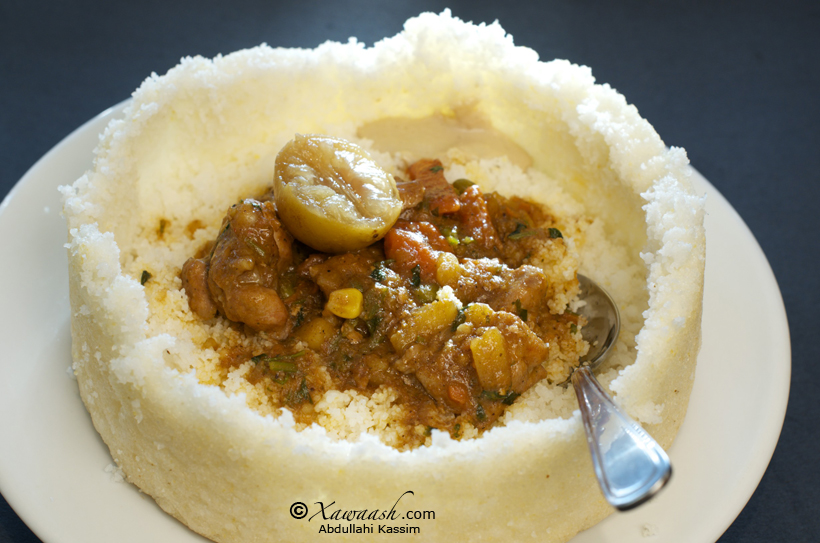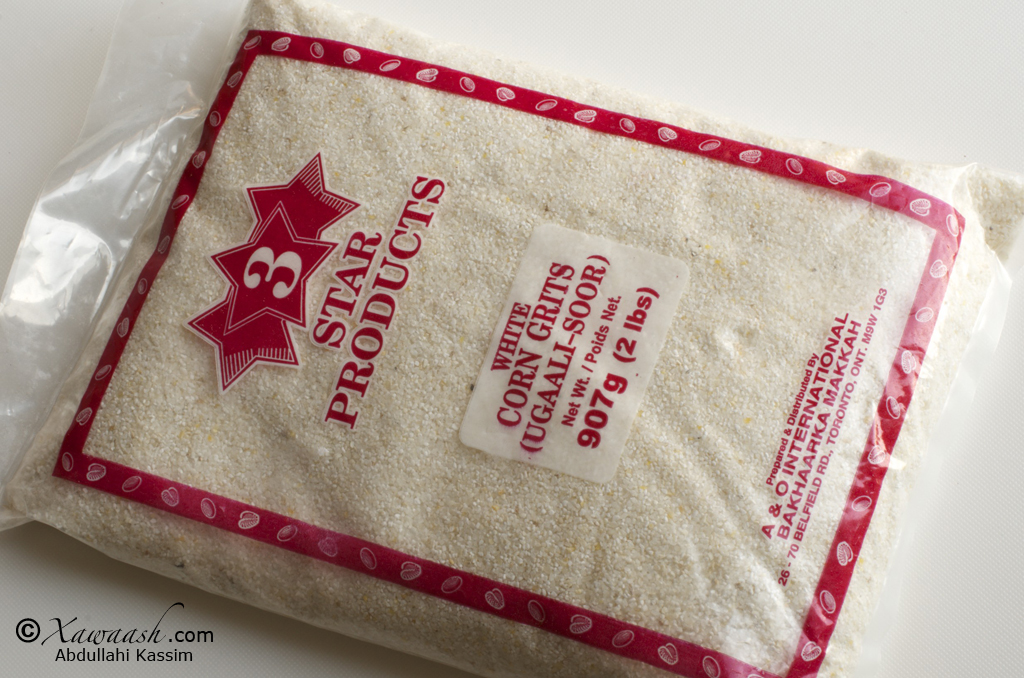Zijjo zaa Gelle (Corn Grits) is a staple in Brava, Somalia. The Bravanese are known for maanda or muufo Baraawe (Bravanese bread), but this is the main dish served for the midday meal. Unlike soor (polenta-style grits) that is popular in other parts of Somalia, these grits are light and fluffy just like couscous. However, unlike couscous the corn grits are gluten-free.
The traditional way of preparing zijjo zaa gelle was very time-consuming and physically demanding. First, a little water (maayi) is added to the dried corn kernels (gelle) and they are pounded with a wooden mortar (chinnu) and pestle (muunti). The pounding is done by two women who establish a rythym as they sing. This takes a few hours until the hull separates. The corn is then transferred to a woven mat (isharafa) for drying. After it has dried, the hull is removed by using a winnowing basket (ltelo).
The crushed corn is put in a woven basket (shkapu) that is balanced on the head as it is carried to a mill (makinaani). The corn is then milled into coarse grits. Back at home, the milled corn is sifted (khtuunga) to separate the corn flour (unga waa gelle) from the grits. The corn flour is used to make a sweet Bravanese bread known as Maanda za Unga (Sweet Corn Flour Bread).
The grits are cooked in a clay pot (chijuungu) that is placed inside a clay oven (ntannu). Usually this is done after the morning maanda has been baked in the clay oven. By then the oven will have cooled down and the grits cook slowly in the oven’s residual heat plus a few embers placed on top of the clay pot.
After transferring the grits from the clay pot, the top crust is returned to the pot. The pot is then filled with buttermilk to soak the crust. This the prized part of the dish and is usually reserved for the cook (mpishi).
The Bravanese serve the grits in two stages. First, it is served with a stew that is usually not tomato-based. Next, the grits are served with buttermilk and a thick tahini paste (maankali). We like to add some sugar to this, but most Bravanese would frown upon this.
Zijjo zaa Gelle (Semoule de Maïs) est un plat de base à Brava, Somalie. Les Bravanais sont connus pour le maanda ou le muufo Baraawe (Pain Bravanais), mais ceci est le plat le plus souvent servi au déjeuner. A la différence du soor (bouillie préparée comme une polenta) qui est populaire dans d’autres régions de Somalie, cette semoule est légère et aérée comme du couscous. Toutefois à la différence du couscous la semoule de maïs est sans gluten.
La méthode traditionnelle de préparation de zijjo zaa gelle prenait beaucoup de temps et d’énergie. D’abord, on verse un peu d’eau (maayi) sur les grains de maïs séchés (gelle) et on écrase avec un mortier (chinnu) et un pilon (muunti) en bois. Deux femmes pilent ensemble en rythme et en chantant. Il faut des heures pour que la membrane se détache. Le maïs est ensuite transféré sur un tapis tressé (ishafara) où il est mis à sécher. Une fois sec, les pellicules du maïs se retirées en utilisant un panier en vannerie (Itelo).
Le maïs broyé est placé dans un panier tressé (shkapu) placé en équilibre sur la tête pour l’amener au moulin (makinaani). Le maïs y est grossièrement moulu. De retour à la maison, le maïs moulu est tamisé (khtuunga) pour séparer la farine de maïs (unga waa gelle) de la semoule. La farine de maïs est utilisée pour faire le pain Bravanais sucré appelé Maanda za Unga (Pain de farine de maïs doux).
La semoule est cuite dans un pot en terre cuite (chijuungu) qui est placé dans un four en terre cuite (ntannu). Il est cuit après que le maanda du matin a été cuit dans le four en terre cuite. A ce moment là le four a refroidi et la semoule cuit doucement dans la chaleur résiduelle du four avec quelques braises posées sur le dessus du pot.
Une fois la semoule retirée du pot, la croûte qui s’est formée est remise dans le pot. On le remplit alors de babeurre pour détremper la croûte. Ce morceau de choix est d’habitude réservé au cuisinier (mpishi).
Les Bravanais servent la semoule en deux étapes. D’abord, elle est servie avec un plat de viande qui en général ne contient pas de tomate. Ensuite, la semoule est servie avec du babeurre et une pâte de sésame épaisse (maankali). Nous aimons lui ajouter du sucre, bien que la plupart des Bravanais ne l’approuveraient pas.
Ingredients:
4 cups (4 x 237ml) White corn grits (yellow grits are just as good)
2 Tbsp Canola (or vegetable) oil
1 tsp Salt
2½ cups Water
Ingrédients:
4 mesures (4 x 237 ml) de semoule de maïs blanc (la semoule de maïs jaune est
aussi bonne)
2 cs d’Huile de Colza (ou d’huile végétale)
1 cc de Sel
2½ mesures d’Eau
Directions:
Wash the grits thoroughly, about four times, until the water runs clear. Drain the water and don’t worry if you can’t drain all the water.
In a non-stick pan set on medium-high heat, bring 2½ cups water to a boil. Add 2 tablespoons of canola (or vegetable) oil and 1 teaspoon of salt. Carefully add the washed grits to the pot and stir. Stir well until the grits thicken.
Cover tightly and cook the grits on very low heat for 1 hour.
Let the grits cool down for at least 15 minutes. Use a fork to transfer the grits to a large bowl. To separate the grains, we used a whisk, which made the task very easy. If a few lumps remain, don’t worry. When you add broth or sauce to the grits, the grains will separate easily.
The non-stick pot makes it easy to slide out the crust. This make a fantastic bowl in which to serve the grits. Alternately, with the crust still in the pot, soak it with enough milk or broth, then serve it.
Instructions:
Bien laver la semoule, environ 4 fois, jusqu’à ce que l’eau soit claire. Égoutter mais ne vous inquiétez pas s’il reste un peu d’eau.
Dans une casserole qui n’attache pas chauffée à feu moyen, faire bouillir les 2 mesures ½ d’eau. Ajouter 2 cuillères à soupe d’huile de colza (ou d’huile végétale) et 1 cuillère à café de sel. Verser doucement la semoule dans la casserole et tourner. Tourner jusqu’à ce que la semoule épaississe.
Bien couvrir et cuire la semoule à feu très doux pendant 1 heure.
Laisser la semoule refroidir pendant au moins 15 minutes. Utiliser une fourchette pour transférer la semoule dans un grand plat. Pour séparer les grains, nous avons utilisé un fouet, ce qui rend la tâche plus simple. S’il reste quelques grumeaux, ne vous inquiétez pas. Lorsque vous ajoutez du bouillon ou de la sauce à la semoule, les grains se séparent facilement.
La casserole anti-adhérente permet de faire glisser la croûte pour la sortir. Elle se transforme en super bol pour servir la semoule. Ou alors, laisser la croûte dans la casserole, la faire tremper dans du lait ou du bouillon, puis la servir.
1. Rincer la semoule quatre fois jusqu’à ce que l’eau soit claire. 2. Dans une casserole anti- adhérente, faire bouillir 2.5 mesures d’eau. 3. Ajouter 2 cuillères à soupe d’huile de colza ou d’huile végétale. 4. Ajouter une cuillère à café de sel. 5. Ajouter la semoule rincée et ne vous inquiétez pas s’il y a un peu d’eau avec. 6. Tourner jusqu’à ce que la semoule épaississe, puis lisser la surface. 7. Bien couvrir et cuire à feu très doux pendant 1 heure.







I love grits. One of my fondest memories was feasting on them as a breakfast cereal. A pat of butter and cold milk, atop, these were delicious! To this day, grits are one of my favorite comfort foods.
I look forward to serving them along side a stew. Yum, yum, yum…
Your photo’s are again, SPECTACULAR!
Thank you very much for your comment. Now we know what we will have for breakfast tomorrow! Grits with butter, milk, and sugar…
Looking really goood and easy to fallow thankz for sharing. when I see the last lemon ka ajar ….af somali maxa loogu waca ii goooysey liin lee dhihi jirney waxaan soo xasuustey beri samadki soonka markuu ahan jirey ayaa ka hor la sameyn jirey dhalo lagu ridi jirey qoraxda la dhigi jirey ala maxaan u xiisey thankz it reminds me of back home and wana share with u that lemonka aajar
Ajaariga ama liinta la-keydiyey waa wax aad u-sahlan sameyskiisa. Annaga mar walba waan sameysannaa. Insha-Allah waan soo gelin doonnaa.
Amazing food, from an Ethiopian.
Big love to our Ethiopian brothers and sisters!
walaalayaal liimo ajaar iyo shatni qunbo ma soo geli kartaan inaan soor furfur karsado aan rabaa laakiin dhedhenkii aa iga maqan waana ajaar iyo shatni pleeease.
Liimo ajaar (Achaari) iyo shatni waxay noogu jiraann liiska. Insha-Allah waan soo gelin doonnaa. Haddii aad degdegsan tahay, ajaarriga waxaa hadda ka-gadan kartaa ‘supermarket’yada carabta (Middle Eastern Supermarkets). Ajaarigaas wuu u-dhow yahay midka aan sameyno. Ajaariga hindida wuu ka-duwan yahay keenna.
your food is like like heaven its something i never tasted before and its speacail.the way its produced is undiscribable and sensasional.its very genourous for u to make this website may allah bless you.
.
Thank you very much for your amazing and wonderful comment! We truly appreciate it.